Urban Management Practices
Green Roofs
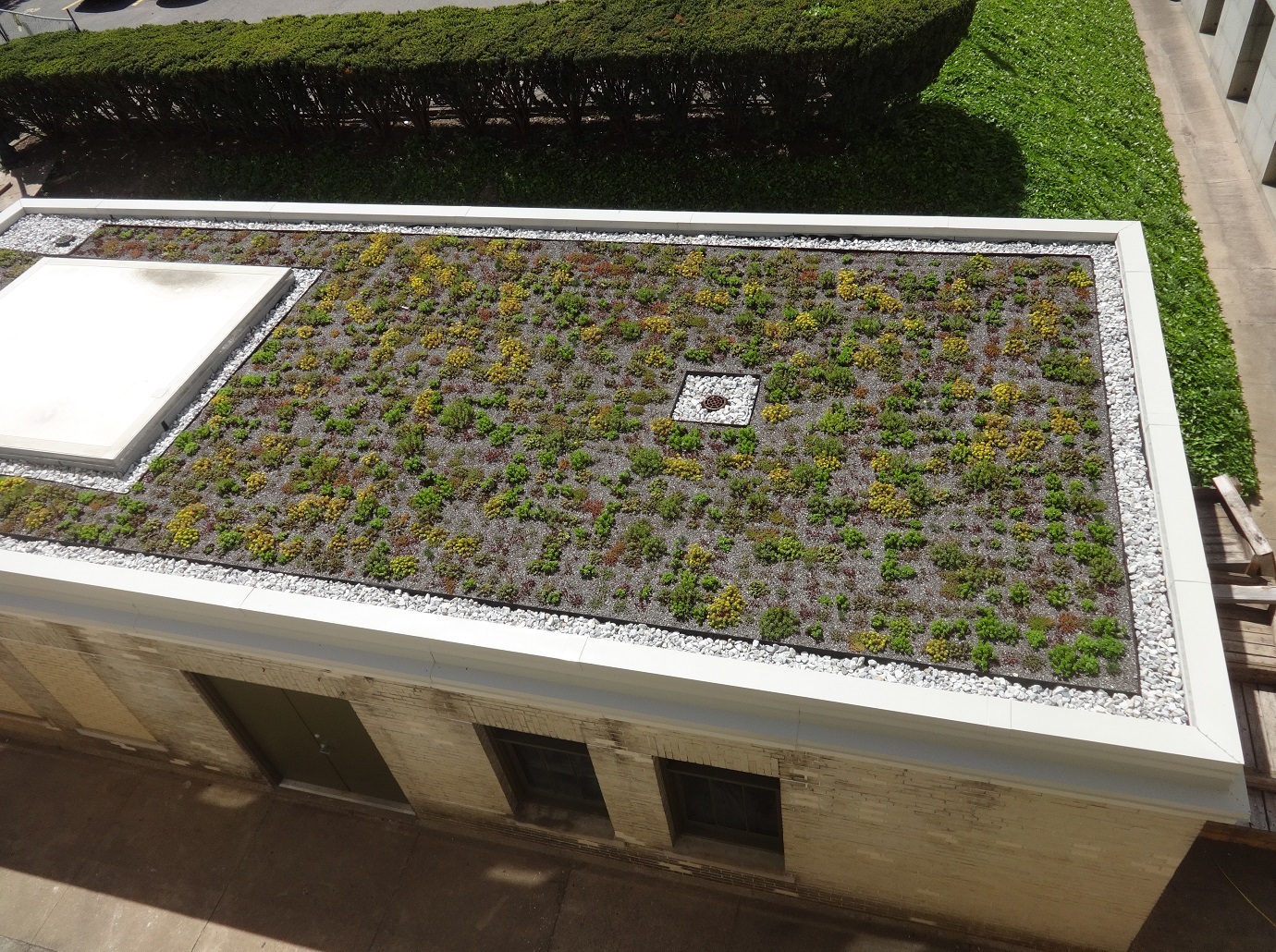
Photo credit: SEAL ENGINEERING INC
Green roofs, sometimes referred to as “ vegetated roofs” or “eco-roofs”, consist of a waterproofing membrane, growing medium (soil) and vegetation (plants) overlying a traditional roof. Green roofs can help mitigate the problems that cities create by bringing the natural cooling, water-treatment and air filtration properties that vegetated landscapes provide to the urban environment. Architects and planners can use green roofs to help solve environmental problems by bringing nature back to the city in key ways. Green roofs properly designed, constructed and maintained, are beneficial socially, environmentally and fiscally. They are an important tool to increase sustainability and biodiversity and decrease energy consumption, urban heat island impacts and greenhouse gas generation.
A typical green roof includes a waterproof barrier to protect the building, a drainage layer to store and direct runoff, a soil or growth medium layer, and a plant layer.
There are two main types of green roofs: extensive roofs, which are relatively inexpensive to install and are used mainly for environmental benefit, and intensive roofs which allow a greater variety and size of plants such as shrubs and small trees but which are usually more expensive to install and maintain, partly due to the need for irrigation. Commercial and public buildings tend to use extensive roofs unless the roofs are intended primarily as occupied garden amenity space.
Green Roof Benefits
The environmental benefits of installing green roofs on commercial and public buildings include:- Improved water quality due to reduced stormwater runoff and fewer overflows of combined sanitary and stormwater sewage systems.
- Increased habitat promoting biodiversity.
- Lower temperatures for building roofs and the air above them in most climates.
- Reduced energy consumption in some climates.
- Improved sound absorption in the top floors of buildings.
- Improved air quality.
References
The above text includes excerpts from the following documents and resources:
1. “The Benefits and Challenges of Green Roofs on Public and Commercial Buildings. A Report of the United States General
Services Administration”
(Click on this link for more details:
U.S. General Services Administration)
Rain Gardens
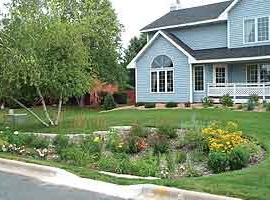
Photo credit: USDA
Rain gardens or bioretention cells are depressional areas landscaped with perennial flowers and native vegetation that soak up rainwater. They are strategically located to capture runoff from impervious surfaces, such as roofs and streets. Rain gardens fill with a few inches of water after a storm and then water filters into the ground, rather than running off to a storm drain.
Designing and Planting
Designing and planting a rain garden is very similar to creating other perennial gardens, with a few of the following exceptions:
Location
Rain gardens must be located to intercept runoff from impervious areas. They can be placed anywhere good soils with adequate percolation rates exist. It is best to keep rain gardens away from building foundations, utilities, and septic systems.
Size
Rain gardens are typically 5 to 10 percent the size of the impervious surface generating the runoff
entering the garden. Measure the square footage of the impervious area (length x width); then
multiply this by 0.07 (7%). Determine a length and width of the rain garden that best fits the
site. For example, a 2,000 sq./ft. roof, when multiplied by 7%, would call for a rain garden 140 sq./ft.
in size, or 14’ long by 10’ wide.
A typical rain garden is between four and eight inches deep. A rain garden less than four inches deep will
need too much surface area to provide enough water storage to infiltrate larger storms. Storm
water runoff should spread evenly across the entire rain garden, to increase the opportunity for
infiltration.
References
The above text includes excerpts from the following documents and resources:
1. United States Department of Agriculture – Natural Resources Conservation Service: Rain Gardens (
click here for more details).
2. United States Department of Agriculture – Natural Resources Conservation Service: Rain Garden Fact Sheet (
click here for more details).
Soil Quality Restoration
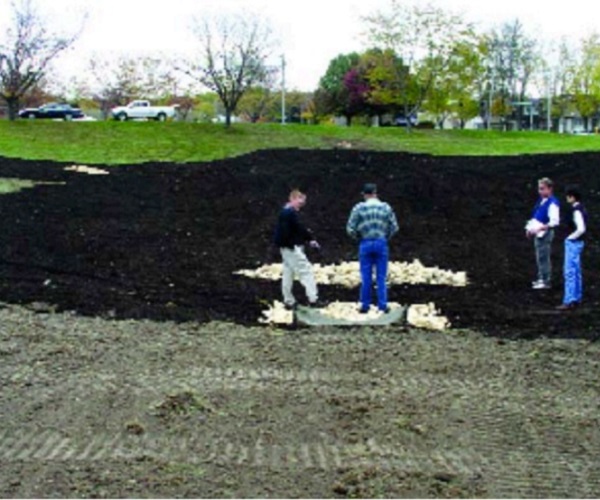
Photo credit: Iowa-NRCS
Soil quality restoration boosts infiltration potential and increases the amount of water that soil can hold, thereby reducing surface runoff and creating a greener, healthier lawn environment. When topsoil is compacted (or sometimes completely removed) and covered with sod, pore spaces and pathways for water to infiltrate can be reduced or destroyed. The mats of grass cover a nearly impenetrable layer of soil, leading to shallow rooting and forcing excess rainwater to run off onto sidewalks, streets and into stormwater systems.
Improving soil quality often begins with aeration. Differing methods exist, ranging from do-it-yourself tools, to equipment rentals, to professional aeration services that will do the work for you. Once the lawn is aerated, compost is applied to incorporate nutrient-rich organic matter. This creates an environment that promotes water infiltration and storage, increased microbial activity, deeper rooting of grasses and plants, better soil structure and overall improved soil quality. Through such improvements, soil function is restored, the need for frequent watering is lessened and water bills are reduced.
Challenges / Limitations
- Soil quality restoration needs to be recognized as a viable component of a storm water management system. Enhancing soil quality reduces the amount of runoff that is shed and improves water quality by absorbing and processing pollutants moving in the first flush of any runoff event.
- Compaction is generally widespread in urban areas due to grading activities associated with development. Compaction is the most difficult challenge when attempting to restore soil quality.
- Performing deep tillage can be challenging in constrained settings.
References
The above text includes excerpts from the following documents and resources:
1. United States Department of Agriculture – Natural Resources Conservation Service: “
Conservation Strategies for Growing Communities”. Iowa-2004.
2. Iowa Learning Farms – Building a Culture of Conservation: “
Urban Conservation Practices”.
Permeable Paving Systems
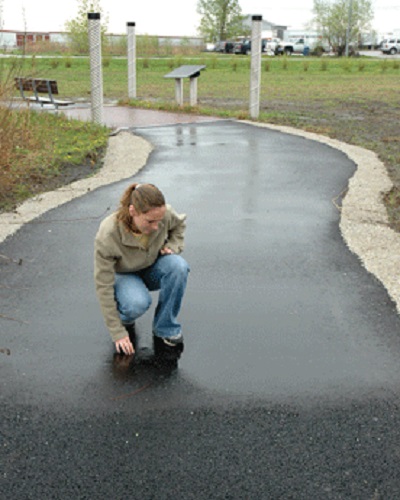
Photo credit: USDA-NRCS Iowa
Pervious paving allows water to infiltrate into layers of limestone placed below the paving and then into soil and groundwater below. By infiltrating most of the storm water on-site, the amount of water and pollution flowing into storm sewers and directly to rivers and streams is greatly reduced. This, in turn, protects water quality, maintains more stable base flows to streams, reduces flood peaks, and reduces stream bank erosion. With infiltration, groundwater is recharged and streams are replenished with cool, clean groundwater in a more natural way. Pervious paving is one component of Low Impact Development (LID).
Depending on the site, pervious paving systems may result in significant savings by eliminating required retention and detention ponds and reducing conventional storm sewers.
Design
Pervious paving systems may be installed at new or existing building sites. On a new or existing site, careful planning is important, including soils tests. Following design standards developed by manufacturers and government agencies is vitally important in assuring the systems work effectively.Pervious paving systems can be designed to infiltrate any storm event, including the 100-year storm. They can also be used strategically with less costly traditional paving to infiltrate small, frequent rains and the first flush of large storms. Because the first flush of storm water carries the most pollutants, cleaning the first flush has excellent water quality benefits.
References
The above text includes excerpts from the following documents and resources:
1. United States Department of Agriculture – Natural Resources Conservation Service (Iowa): Pervious Paving Systems (
click here for more details).
2. Iowa Learning Farms – Building a Culture of Conservation: “Urban Conservation Practices” (
click here for more details).
Bioswales
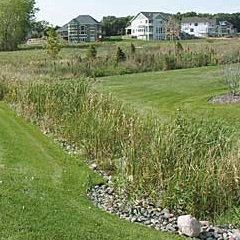
Photo credit: USDA-NRCS-Montana
Bioswales are storm water runoff conveyance systems that provide an alternative to storm sewers. They can absorb low flows or carry runoff from heavy rains and snowmelt to storm sewer inlets or directly to surface waters. Bioswales improve water quality by enhancing infiltration of the first flush of storm water runoff and filtering the large storm flows they convey. About 30 to 40 percent of Montana’s annual precipitation comes from small rain events. Much of the value of bioswales comes from filtering nearly all of this water.
Designing a Bioswale
For best results, enhance and utilize existing natural drainage swales whenever possible. Maintain riparian areas before and during construction to act as “natural” bioswales.
Existing swales can be enhanced with native plants. The thicker and heavier the grasses, the better the swale can filter out contaminants. Additionally, subgrade drains and amended soils may be needed to facilitate infiltration. Other considerations when designing or maintaining bioswales:
- Costs vary greatly depending on size, plant material, and site considerations. Bioswales are generally less expensive when used in place of underground piping.
- Deep-rooted native plants are preferred to promote water infiltration and reduce maintenance. They are also better at controlling erosion.
- Evaluate site soil conditions. Soil infiltration rates should be greater than one-half inch per hour.
- Avoid soil compaction during installation.
- A parabolic or trapezoidal shape is recommended with side slopes no steeper than 3:1.
- Collaborative projects with neighbors and adjacent property owners are usually more effective at reducing runoff.
- Swales should be sized to convey at least a 10-year storm (or about 2.4 inches in 24 hours).
References
The above text includes excerpts from the following documents and resources:
1. United States Department of Agriculture – Natural Resources Conservation Service - Montana: Bioswales (
click here for more details).
Urban Ponds
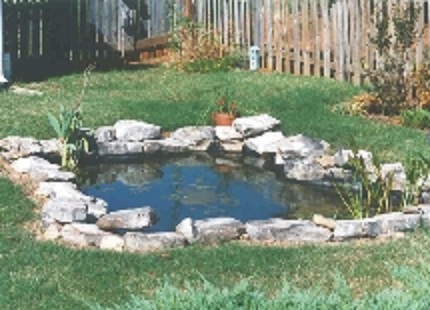
Photo credit: USDA-NRCS-Alabama
Urban Ponds or stormwater urban wetlands serve to capture and temporarily store water on a larger scale than bioswales. Stormwater wetlands are designed to capture and treat urban runoff before it can be deposited directly to streams and lakes. Natural biological processes filter and remove pollutants from the water as it moves through these wetlands. Like their smaller counterpart, these wetlands also bring an element of native Iowa back onto the landscape, bringing natural beauty and increased bird and wildlife habitat to urban areas. Contrary to popular belief, functioning wetlands actually reduce mosquito numbers as they provide essential habitat for frogs, dragonflies, damselflies and other predators.
Benefits of urban ponds
- High pollutant removal efficiency for soluble pollutants and particulates; one of the most effective stormwater practices in terms of pollutant removal
- Can reduce oxygen-demanding substances and bacteria from urban runoff
- Can provide great amounts of biological uptake of nutrients by wetland plants
- Can reduce peak discharges and flood attenuation; helping prevent downstream channel erosion and sediment loading
- Provide aesthetic and potential recreational value to the community; can be used as a source of public education about wetlands and their benefits
- Can enhance vegetation diversity and create aquatic and terrestrial habitat
Limitations of urban ponds
- Can release some nutrients in the fall and winter months
- Discharge of warmer, stored water from the wetland can raise the temperature of downstream receiving waters, and therefore, their use should be limited in areas that are ecologically sensitive to temperature changes
- Relatively larger land requirements and higher construction costs than other BMPs
- Concern for creating potential breeding habitat for mosquitos
- Use in highly developed areas is fairly limited due to space constraints
- Possible bacterial contamination if waterfowl population become dense
References
The above text includes excerpts from the following documents and resources:
1. Wyoming Department of Environmental Quality – “Urban Best Management Practice Manual” (
click here for more details).
2. Iowa Learning Farms – Building a Culture of Conservation: “Urban Conservation Practices” (
click here for more details).
Rainwater Harvesting
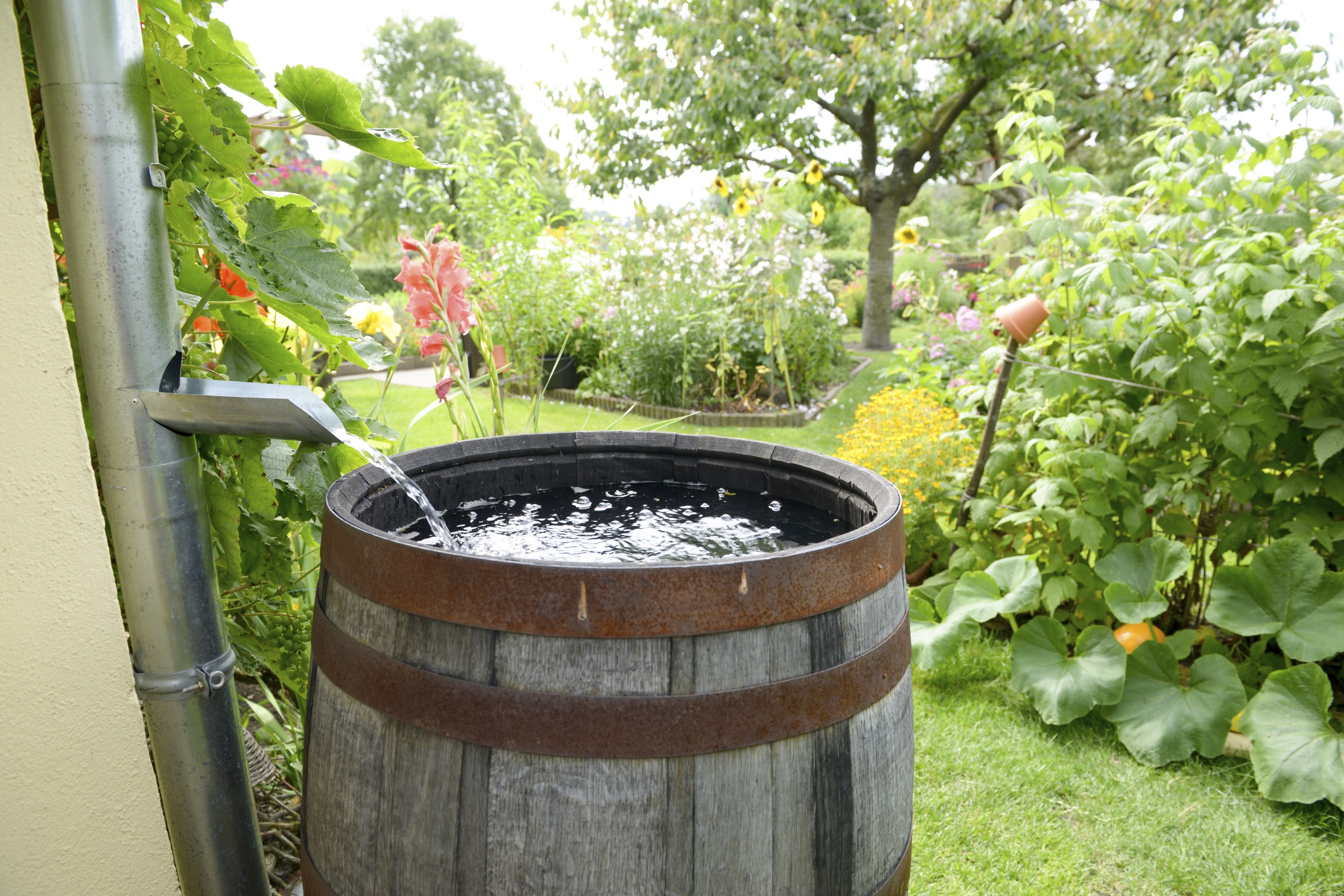
Credit: Gardening Tips for Riverside, CA
Rainwater harvesting is the practice of collecting rainwater for future use, lessening the amount of surface runoff being directed to storm sewers. Rain barrels can collect some of the rain falling on the roof of your home or garage. The captured water can then be used later to water plants and trees, lawns, or even wash cars (best done on the grass rather than on the driveway).
Rainwater harvesting treats rainwater as a valuable resource to be collected and used, rather than conveyed away. Rain barrels, generally 50- to 100-gallon containers, are a traditional method of rainwater harvesting. They are typically used to collect and temporarily store rainwater from rooftops using the gutter and downspout system (Figure 1). Collected rainwater is most often used to water landscape or container plants, or diverted to planted areas for infiltration into the soil.
Benefits of Using Rain Barrels
Rain barrels, especially when used along with other rainwater harvesting methods, provide many benefits that lead to conservation and protection of water resources. While rain barrels are limited in the amount of rainwater that can be collected, they are a good introduction to rainwater harvesting. Beyond their direct benefits, they help raise public awareness of stormwater issues.
Collected rainwater can be an alternative water source to supplement irrigation of trees, shrubs, and flowers, thus conserving municipal drinking water or residential well water. Rainwater harvesting reduces the volume of stormwater runoff and associated pollutants flowing from a property, which helps reduce the amount of pollutants entering streams, rivers, and lakes.
References
The above text includes excerpts from the following documents and resources:
1. NebGuide – Nebraska Extension – Stormwater Management: “Rainwater Harvesting with Rain Barrels”(
click here for more details).
2. Iowa Learning Farms – Building a Culture of Conservation: “Urban Conservation Practices” (
click here for more details).


